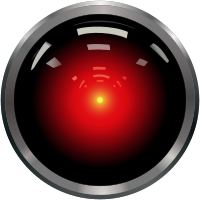Poole versus HAL 9000

"Thank you for a very enjoyable game."
Poole versus HAL 9000 is a fictional chess game in the movie 2001: A Space Odyssey. Astronaut Dr. Frank Poole is seen playing a recreational game of chess with the HAL 9000 supercomputer. Poole views the board on a computer screen and dictates his moves orally to HAL using descriptive notation. Poole is not surprised when the presumed infallible supercomputer soundly defeats him.
In the novel, no particular chess game is depicted, although it is mentioned that the astronauts can play chess and other games with HAL, and that, for the purpose of morale, the computer is programmed to temper its superiority by winning only 50% of games.
The film's director Stanley Kubrick was a passionate chess player, so unlike many chess scenes shown in other films, the position and analysis make sense. The actual game seems to come from a tournament game between A. Roesch and W. Schlage, Hamburg 1910.[1]
The game
Schlage (HAL 9000)
| a | b | c | d | e | f | g | h | ||
| 8 |  | 8 | |||||||
| 7 | 7 | ||||||||
| 6 | 6 | ||||||||
| 5 | 5 | ||||||||
| 4 | 4 | ||||||||
| 3 | 3 | ||||||||
| 2 | 2 | ||||||||
| 1 | 1 | ||||||||
| a | b | c | d | e | f | g | h | ||
The game depicted in the film seems to be based on the moves of the following tournament game played in Hamburg, 1910:
White: A. Roesch Black: W. Schlage Opening: Ruy Lopez (ECO C86)
1. e4 e5 2. Nf3 Nc6 3. Bb5 a6 4. Ba4 Nf6 5. Qe2 b5 6. Bb3 Be7 7. c3 0-0 8. 0-0 d5
- The opening is the Ruy Lopez, Worrall Attack, followed by a pawn sacrifice by Black.
9. exd5 Nxd5 10. Nxe5 Nf4 11. Qe4 Nxe5 12. Qxa8?
- 12.d4 leads to a slight plus for White.[2]
12... Qd3! 13. Bd1 Bh3!
- Black capitalizes on White's mistake on move 12. The film shows the game from the position illustrated, with Poole (White) contemplating his 14th move.
14. Qxa6?
- White abandons the long diagonal and slips into a forced checkmate. Even after 14.Qb7 c6 15.Qxe7 Bxg2 16.Re1 Nf3+ 17.Bxf3 Qxf3, mate is not far off.
14... Bxg2 15. Re1 Qf3
- Threatening 16...Nh3#. Here HAL says: "I'm sorry Frank, I think you missed it: queen to bishop three, bishop takes queen, knight takes bishop, mate." But HAL's description of the queen move is not technically correct—the move is described in descriptive notation as "queen to bishop six". Also, while HAL describes a checkmate in two moves, Poole could forestall mate two additional moves, for example 16.Qc8 Rxc8 17.h3 Nxh3+ 18.Kh2 Ng4#.[3]
- Poole resigns without questioning HAL's analysis: "Yeah, looks like you're right. I resign."
See also
References
- ^ "Roesch vs. Willi Schlage, Hamburg 1910". Chessgames.com.
- ^ Matanović, Aleksandar, ed. (1981), Encyclopaedia of Chess Openings, vol. C (2nd ed.), Yugoslavia: Chess Informant, p. 412, n. 81,
12.d4 Bb7 13.Qxf4 (13.Qxb7 Ne2+ 14.Kh1 Nxc1 15.Rxc1 Nd3 16.Rf1 c5 =/∞) 13...Nd3 14.Qf5 Nxc1 15.Rxc1 g6 16.Qg4 Bg5 17.Rd1 +/=
- ^ Wall, Bill (22 June 2007). "2001: A Chess Space Odyssey". Chess.com. Retrieved 14 January 2014.
External links
- Campbell, Murray S. "An Enjoyable Game": How HAL Plays Chess. Archived from the original (pdf) on 1998-01-14.
{{cite book}}: Unknown parameter|deadurl=ignored (|url-status=suggested) (help) - Stork, David G., ed. (1998). HAL's Legacy 2001's Computer As Dream and Reality. Foreword by Arthur C. Clarke. Cambridge: MIT Press. ISBN 9780262692113.
- Krabbé, Tim (1999). "Willi Schlage".
The only unknown to become immortal twice
- hal compyuter on YouTube
